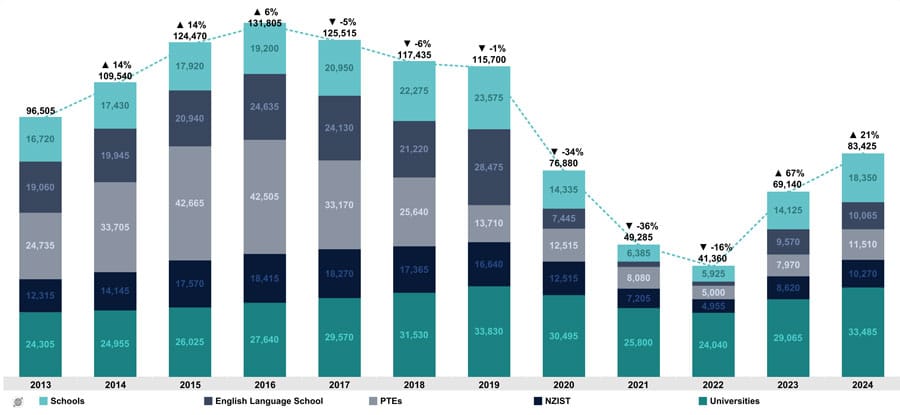New Zealand announces strong foreign enrolment growth along with a new international education strategy
- International student enrolment in New Zealand grew by 21% between 2023 and 2024 as the country continues to rebuild toward pre-pandemic benchmarks
- The government has announced a new growth strategy that aims to double the economic impact of the sector by 2034
- Policy makers are taking steps to align New Zealand’s visa rules with those ambitious targets, starting with an expansion of in-study work rights for visiting students
Following a post-pandemic surge in 2023, Education New Zealand (ENZ) announced this week that the country's international student enrolment grew by another 21% in 2024. With total enrolment of 83,425 foreign students during the year, New Zealand's international education sector has now recovered to 72% of pre-pandemic levels.

"Universities and government-funded private training establishments (PTEs) are close to matching 2019 enrolment numbers," said Education New Zealand Chief Executive Amanda Malu. "We are seeing enrolments grow across universities, schools, Te Pūkenga/NZIST, government-funded PTEs, and English language schools subsectors. In 2024, the strongest year-on-year growth was seen at government-funded PTEs (+59%) along with primary (+53%) and intermediate (+32%) schools."
ENZ reports that graduate studies is another important growth area. "Between 2023 and 2024, there has been a 68% increase in master’s enrolments, with 14,695 international students in 2024, up from 8,740 in 2023," adds Ms Malu. "This is an 85% increase compared to 2019 when we had 7,945 enrolments for master’s study."
As of last year, nearly half of all international students in New Zealand (40%) were enrolled in university studies. Another 22% were in K-12 schools, 14% in PTEs, and 12% in NZIST, and 12% in English language studies.
Most student arrive from key Asian sending markets, including China (34% of 2024 enrolments), India (14%), Japan (9%), South Korea (4%), and Thailand (3%). The United States (3% of 2024 enrolments) and Germany (another 3%) are the only non-Asian markets to appear in the top ten senders for New Zealand for 2024.
Going for growth
Education Minister Erica Stanford released a new international education strategy for New Zealand on 14 July 2025. The "International Education Going for Growth" strategy aims to double the economic impact of the sector in New Zealand over the next decade, expanding from NZD$3.6 billion as of 2024 to NZD$7.2 billion by 2034.
The plan centres on three core objectives, each of which signals the country's intent to pursue a managed growth strategy that will see international student numbers expand gradually over the next ten years.
- To raise awareness of New Zealand as a study destination from 40% in 2024, to 42% in 2027 and 44% by 2034.
- To grow student enrolments from 83,400 in 2024 to 105,000 in 2027 and 119,000 by 2034.
- To increase the proportion of prospective students rating NZ among their top three choices of study destination from 18% in 2024 to 20% in 2027 and 22% in 2034.
“International education is one of our largest exports, injecting NZD$3.6 billion into our economy in 2024. It also provides opportunities for research, strengthening trade and people-to-people connections, which are important to drive investment, productivity and innovation in New Zealand," said Minister Stanford. “With international student enrolments steadily increasing since 2023, we want to supercharge that growth track and make New Zealand the destination of choice for international students."
The plan also sets out a number of core strategies, specifically that New Zealand will:
- "Launch a high-profile global branding campaign to showcase NZ education’s unique advantages and raise awareness in key international markets.
- Implement an improved agent network model that standardises training and engagement with recruitment agents to increase effectiveness in student outreach and enhance education provider collaboration with agents.
- Advance our AI-driven platform providing round-the-clock support and information to prospective students and partners worldwide, improving responsiveness and service quality."
Linking plan to policy
The Going for Growth plan also highlights that New Zealand is moving to streamline student visa processes and open up additional work rights for visiting students.
For the moment, this includes an announcement this week that limits on in-study work rights will be expanded from 20 hours week to 25 hours per week for eligible student visa holders as of November 2025. Eligibility for in-study work will also be extended to "all tertiary students in approved exchange or Study Abroad programmes, including programmes one-semester long."
The government has also indicated that it intends to further explore the introduction of a short-duration work visa of up to six months "to provide some international graduates who do not qualify for post-study work rights, allowing time to seek employment in their field of study under the Accredited Employer Work Visa (AEWV) pathway."
"In the short term, Education New Zealand will focus its promotional efforts on markets with the highest potential for growth," adds Minister Stanford. "We’re taking a considered and strategic approach. It’s important to strike the right balance between increasing student numbers, maintaining the quality of education, and managing broader impacts on New Zealanders. Our plan will deliver that.”
For additional background, please see:
- "New Zealand resource aims to connect prospective international students with qualified agents"
- "New Zealand: International student enrolments up 67% in 2023 amid growing public support"
- "New Zealand expands work rights for accompanying dependants of foreign students"
- Of special note to agency-based counsellors: the New Zealand Education Agent Course. Join this online course for a comprehensive understanding of New Zealand’s education system and study options, and to develop specialist skills for advising students who wish to study in the country.
















